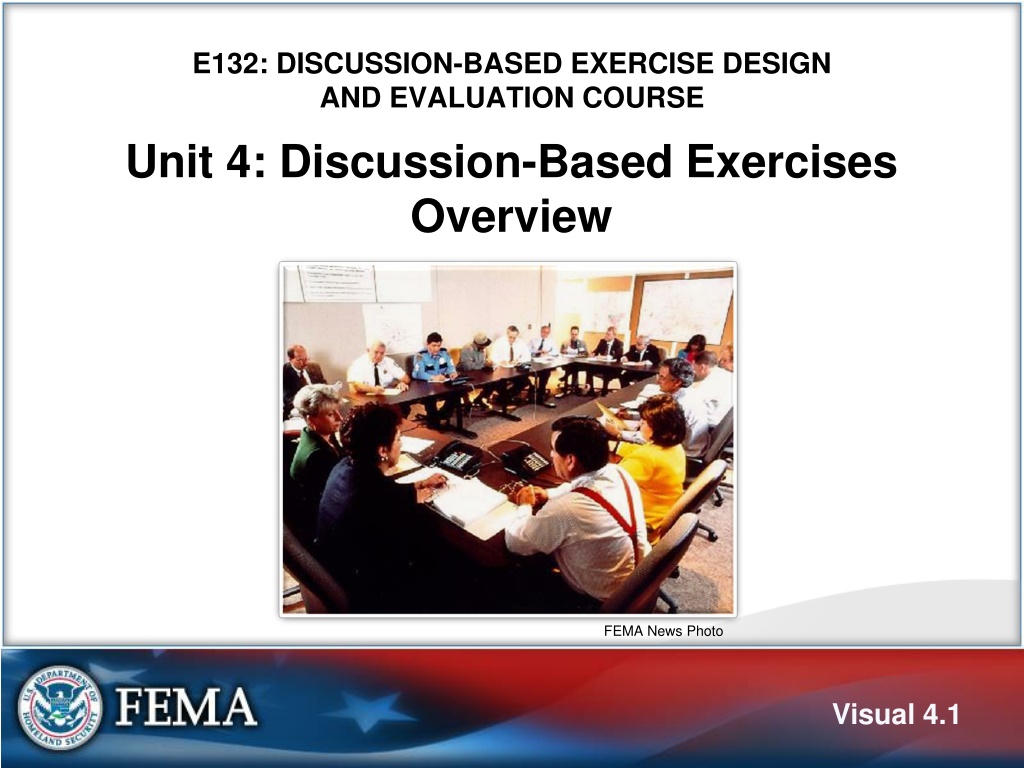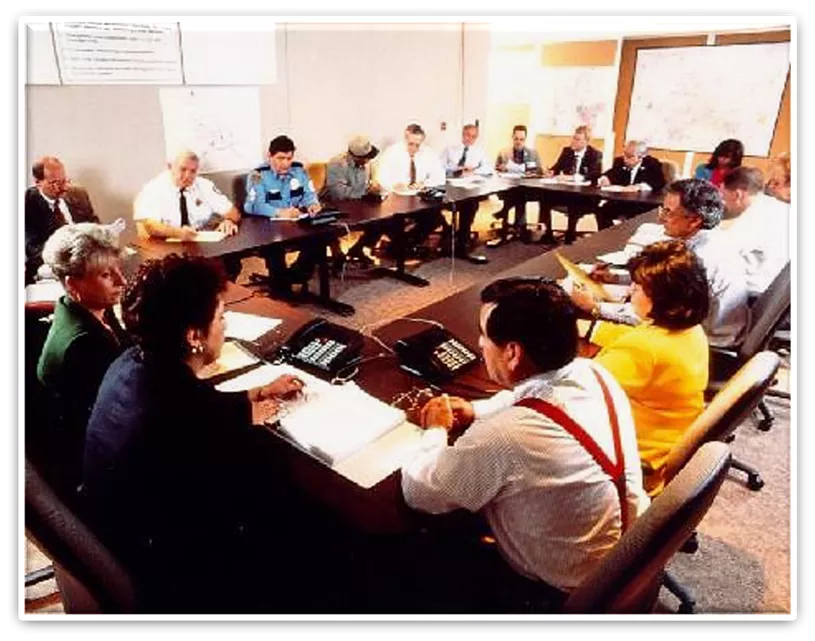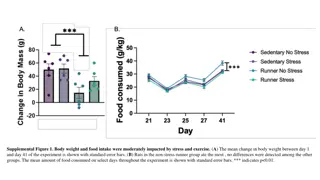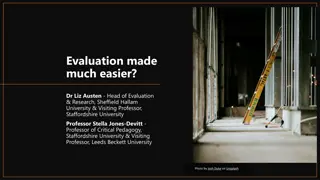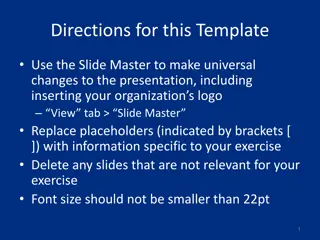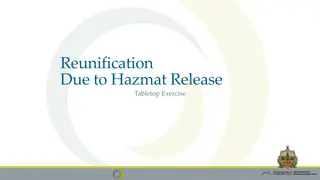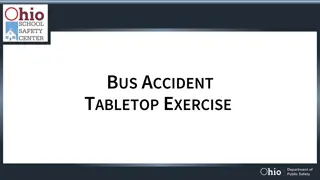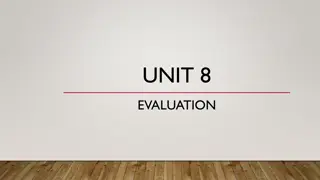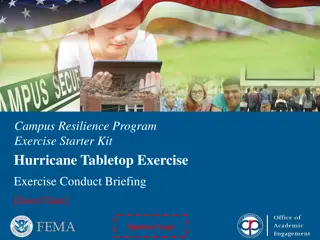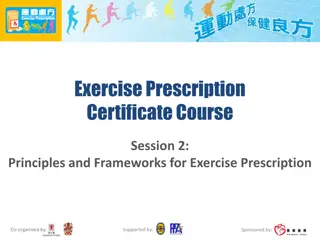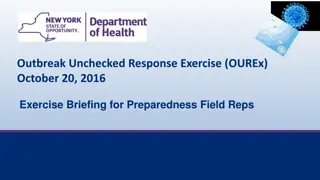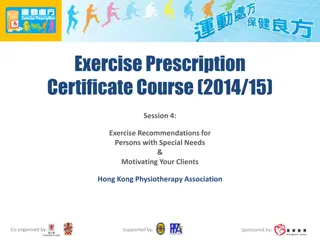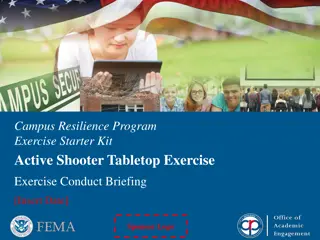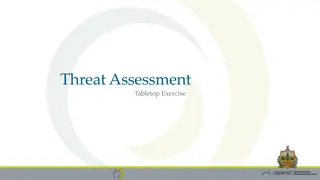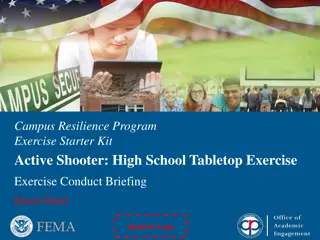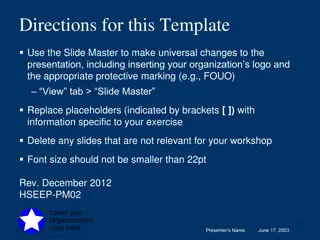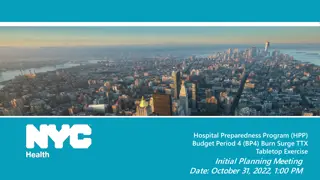Discussion-Based Exercise Design & Evaluation Overview
This course unit covers types of discussion-based exercises, eight exercise design steps, and conducting seminars for emergency preparedness. Learn about the progressive approach, why the exercise design steps are crucial, and how to assess needs for effective planning.
Download Presentation

Please find below an Image/Link to download the presentation.
The content on the website is provided AS IS for your information and personal use only. It may not be sold, licensed, or shared on other websites without obtaining consent from the author.If you encounter any issues during the download, it is possible that the publisher has removed the file from their server.
You are allowed to download the files provided on this website for personal or commercial use, subject to the condition that they are used lawfully. All files are the property of their respective owners.
The content on the website is provided AS IS for your information and personal use only. It may not be sold, licensed, or shared on other websites without obtaining consent from the author.
E N D
Presentation Transcript
E132: DISCUSSION-BASED EXERCISE DESIGN AND EVALUATION COURSE Unit 4: Discussion-Based Exercises Overview FEMA News Photo Visual 4.1
Unit Objectives By the end of this unit you will be able to: Describe the types of discussion-based exercises Describe the eight exercise design steps Develop SMART objectives Design, develop, and conduct a seminar for the Liberty County Policy Group Visual 4.2
Types of Discussion-Based Exercises There are four types of discussion-based exercises: 1. Seminars 2. Workshops 3. Tabletop exercises 4. Games Visual 4.3
Progressive Approach Discussion-based exercises are the first step in the progressive approach to exercises Visual 4.4
Eight Exercise Design Steps 1. Assess needs 2. Define the scope 3. Write a statement of purpose 4. Define objectives 5. Compose a narrative 6. Write major and detailed events 7. List expected actions 8. Prepare messages Modified for discussion- based exercises Visual 4.5
Eight Exercise Design Steps Why use the Eight Exercise Design Steps? The process is critical to having a systematic exercise design They make the exercise process much simpler and smoother They are one way of implementing HSEEP They are a FEMA and exercise industry best practice They improve exercises This is where the mastery comes in Visual 4.6
Step 1: Assess Needs The best way to determine whether you need an exercise and what kind of exercise is needed is to conduct an exercise needs assessment An exercise needs assessment: Defines problems Establishes reasons to do an exercise Identifies capabilities to be exercised Visual 4.7
Begin With Your Plan An exercise needs assessment should begin with a review of the emergency plan and should address: Hazards Secondary hazards Hazard priority Area Plans and procedures Capabilities Players Program areas Past exercises Visual 4.8
Lessons Learned Learn from past exercises: Who participated? To what extent were objectives achieved? What lessons were learned? What problems were revealed, and what is needed to resolve them? What improvements have been made since, and have they been tested? Visual 4.9
Needs Assessment Results Primary and secondary hazards Problems, weak capabilities Skills requiring practice Improvements requiring testing Untested facilities, personnel, equipment Weaknesses in emergency plan or SOPs Need for role clarification Need for certain types of exercises Visual 4.10
Needs Assessment Results (contd.) Did you cover the topics listed on the prior slide when assessing the needs for your Multi-year TEP? Discussion Visual 4.11
Step 2: Define the Scope Defining the scope = Setting realistic limits Factors that help define scope: Expense Availability of personnel and other resources Seriousness of the problem Capacity of the exercise to address the problem Planning team s skills and experience Exercise length Visual 4.12
Six Key Elements Scope includes the: Type of emergency/hazard Location Capabilities Participants Exercise type Duration Visual 4.13
Six Key Elements (contd.) When defining the scope of your exercise, what are some factors you would consider in choosing the type of emergency/hazard? Discussion Visual 4.14
Six Key Elements (contd.) Type of Emergency/Hazard In choosing the type of emergency, ask yourself: What emergencies will generate the types of actions that need to be practiced? What are the high-priority hazards the organization faces? What hazards have not been recently exercised? Are there problems that have recently developed? Are there policy concerns surrounding the hazard/scenario? What plans are involved with this hazard/scenario? What secondary events might develop as the scenario develops? Visual 4.15
Six Key Elements (contd.) Location Identify the location where the simulated event will occur Consider the logistics of the chosen site Visual 4.16
Six Key Elements (contd.) Capabilities List the capabilities that the players will exercise (should be supported by the TEP) List the operations or functions that the participants will discuss Be sure that the procedures within a certain function are clear and narrowly defined Visual 4.17
Six Key Elements (contd.) Participants Narrow the list to those organizations and individuals who are required to hold a good discussion or carry out the actions More is not always better Visual 4.18
Six Key Elements (contd.) Exercise Type What exercises are most needed? What experience have personnel had with various types of exercises? What stress level do we want? What types of exercises are mandated by regulatory requirements? Visual 4.19
Step 3: Write a Statement of Purpose Purpose statement: A broad statement of the exercise goal Governs objectives, which determine subsequent steps Clarifies reasons for the exercise Is useful for communicating with media and community Visual 4.20
Developing the Purpose Statement Incorporate the scope decisions (type of emergency, location, capabilities, organizations, and exercise type) into a single sentence Include a date Sample purpose statements in Participant Guide Visual 4.21
Step 4: Define Objectives A description of the capabilities and expected actions that should occur What the exercise is intended to accomplish FEMA News Photo Visual 4.22
Why Define Objectives? Objectives are essential for: Design process Exercise conduct Evaluation Improvement planning Visual 4.23
How are Objectives Determined? Many objectives become evident at the time of the exercise needs assessment Objectives are also arrived at by breaking down a purpose statement into its logical components Visual 4.24
How Many Objectives? Typically: Tabletop exercises between 3 to 5 Functional exercises between 4 to 7 Full-scale exercises 8+ The number of objectives selected for an exercise should be limited Visual 4.25
What Makes a Good Objective? Clear, concise, focused on performance Should contain: Action, stated in observable terms The entity (agency/jurisdiction) performing that action Conditions under which the action will be performed Standards (or level) of performance Should state who should do whatunder what conditionsaccording to what standards Visual 4.26
Example of a Good Objective Specific action Discuss the plans for Central City s incident command activation of essential HAZMAT personnel during a chemical incident in Central City in accordance with existing standard operating procedures (SOPs). Who Condition Standard Visual 4.27
Example of a Good Objective (contd.) Standard Condition Within 15 minutes after the evacuation notice is given, members of the EOC will complete notification procedures to school administrators. Who Specific action Visual 4.28
SMART Objectives Specific Measurable Achievable Relevant Time-bound Visual 4.29
Writing SMART Objectives How do you write SMART objectives for a TTX? Discussion Visual 4.30
Writing SMART Objectives (contd.) Objectives for discussion-based exercises typically focus on strategic, policy-oriented issues Objectives for operations-based exercises typically focus on the integration of multiple entities and systems-level and tactical-level issues that are physically demonstrated either in an EOC or in the field Visual 4.31
Writing SMART Objectives (contd.) Discussion-based exercise example: Restoration of Lifelines Evaluate Central City s recovery plan to manage clearing and restoration activities, including the restoration of essential gas, electric, oil, communications, water, sewer, transportation/transportation infrastructure, and other utilities in the aftermath of a catastrophic incident Visual 4.32
Writing SMART Objectives (contd.) Share an example of an objective from an exercise you have designed. Discussion Visual 4.33
Word Choice Use concrete words Pay attention to the verb that describes participant performance Use action verbs Avoid vague verbs Visual 4.34
Word Choice (contd.) Useful action verbs include: Assess Clarify Define Determine Demonstrate Establish Evaluate Additional verbs provided in Participant Guide Examine Explain Identify Inspect List Notify Operate Prepare Record Report Show Test Visual 4.35
Is This a Useful Objective? To demonstrate an understanding of the procedures necessary in protecting responder health and safety Visual 4.36
Activity #2: Good or Poor Objectives? Visual 4.37
Activity #2: Good or Poor Objectives? (cont d.) 1. Refer to Activity #2: Example: Good or Poor Objectives? Worksheet in your Participant Guide 2. Review the objectives and determine if they are good or poor 3. Record your answers on the worksheet 4. Work individually 5. You have 10 minutes to complete the activity Visual 4.38
Activity #3: TTX Objectives Visual 4.39
Activity #3: TTX Objectives (contd.) 1. We will run through an example first, then it will be your turn Visual 4.40
Activity #3: TTX Objectives Example Who: Central City Policy Group What: Long-term housing Conditions: Post-catastrophic dam failure Standards: National Long Term Housing Strategy Visual 4.41
Activity #3: TTX Objectives (contd.) SMART Objective The Central City Policy Group will discuss long-term housing strategies and options in response to a catastrophic dam failure in accordance with the National Long Term Housing Strategy. Visual 4.42
Activity #3: TTX Objectives (contd.) 1. Refer to Activity #3: TTX Objectives Worksheet in your Participant Guide (2 pages) Part One: Create SMART objectives for a discussion-based exercise using the information provided Part Two: Create SMART objectives for a discussion-based exercise using your group s disaster category and priority 2. Record your answers on the worksheet Visual 4.43
Activity #3: TTX Objectives (contd.) PART ONE Objective #1: Who: Central City Policy Group What: Citizen warning Condition: Tornado Standard: Central City/Liberty County Basic Emergency Plan Visual 4.44
Activity #3: TTX Objectives (contd.) PART ONE (cont d.) Objective #2: Who: Central City Policy Group What: Economic Recovery Condition: Category 3 Hurricane Standard: FEMA s National Disaster Recovery Framework and Recovery Support Functions Visual 4.45
Activity #3: TTX Objectives (contd.) PART ONE (cont d.) Objective #3: Who: Central City Policy Group What: Mandatory Evacuation Condition: Category 3 Hurricane Standard: Central City/Liberty County Basic Emergency Plan Visual 4.46
Activity #3: TTX Objectives (contd.) PART TWO 1. Create two SMART objectives for a discussion-based exercise applicable to your group s disaster category and priority 2. Record your answers on the worksheet 3. Work in your groups 4. You have 15 minutes to complete PART TWO Visual 4.47
Step 5: Compose a Narrative Narrative: A brief description of the scenario events that have occurred up to the beginning of the exercise Sets participant interest Provides information that sets the stage for later action Visual 4.48
Narrative Characteristics A good narrative: Is located in the SitMan Is usually divided up into modules that represent time Is very specific Is phrased in present tense Is written in short sentences May develop the situation chronologically (event with warning time) May emphasize the emergency environment Visual 4.49
Example: Airplane Crash Narrative Read the Airplane Crash Narrative in your PG, and then answer the following questions: 1. What is the event? 2. How fast, strong, deep, or dangerous is it? 3. How did you find out? 4. What response has been made? 5. What damage has been reported? 6. What is the sequence of events? 7. 8. 9. 10. What are the relevant weather conditions? 11. What other factors would influence emergency procedures? 12. What is predicted for the future? How much time has elapsed? Was there advance warning? Where does it take place? Visual 4.50
